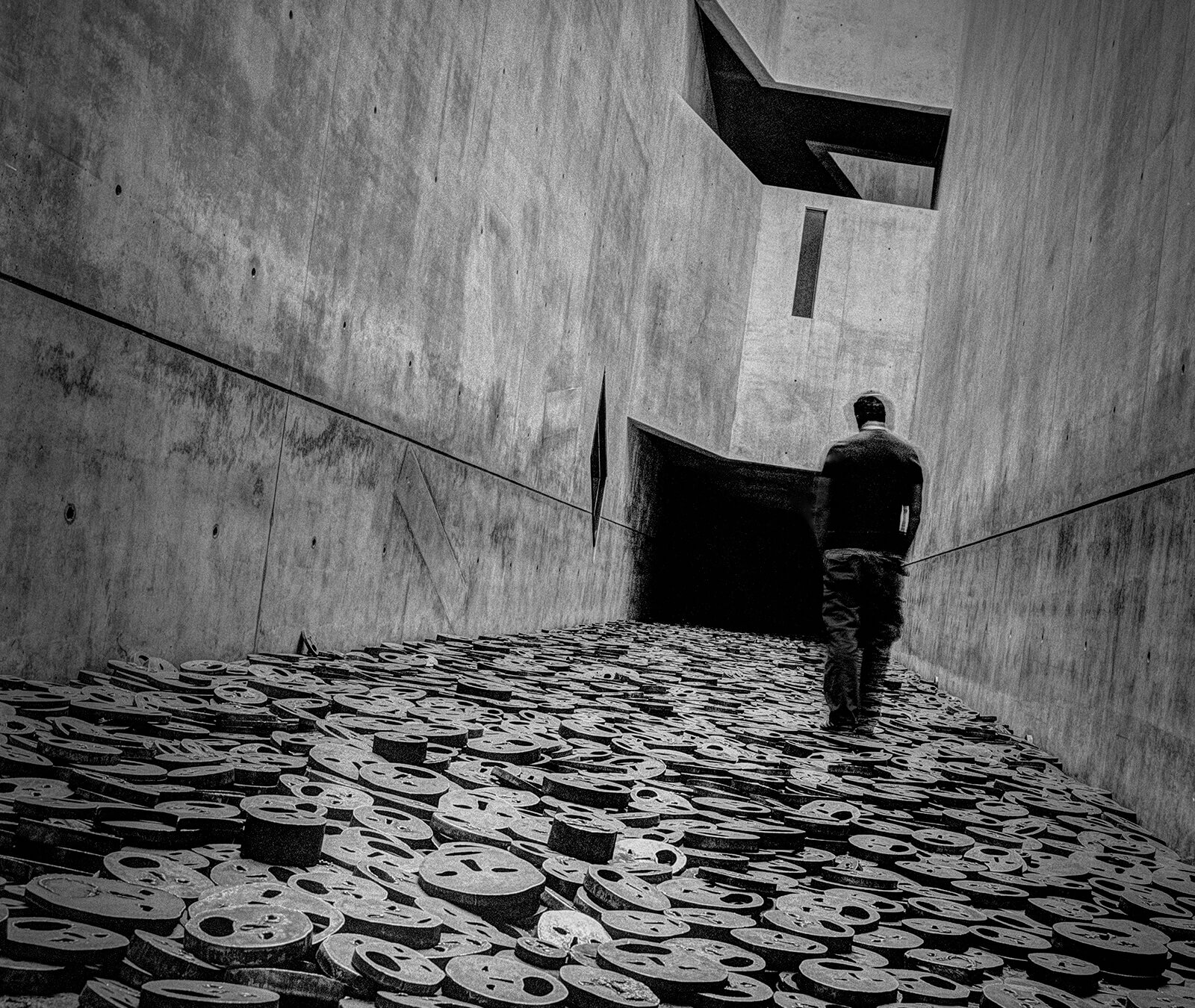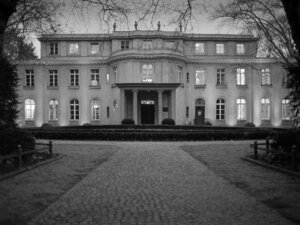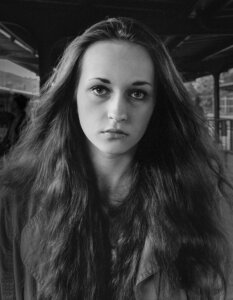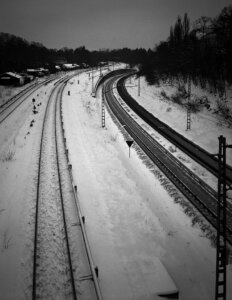To be a Jew in Berlin is to be a stranger in an all-too-familiar land
Jason Langer’s photographs confront the contradictions of ordinary life playing out on sites of mass murder

“Jewish Museum Berlin,” by Jason Langer. Photo by Jason Langer
in Berlin, Jason Langer’s black-and-white photographs of the German capital are an unnerving amalgam of the past and present, lightness and darkness; contradiction and clarity; monumental and banal.
From his home in Portland, Oregon, Langer, 56, talked with me about one particular picture of a dusty, abandoned and untended space in a parking lot, which at one time housed Hitler’s residence, specifically Hitler’s bedroom. It is unmarked.
“Is this a historically important place or one that is deservedly reduced to nothing or both?” he mused.
Berlin, a 172-page coffee table book, focuses on sites of historical significance to Jews — where they lived and where they were killed or deported. Other shots depict contemporary Berliners going about their business — sunbathing, training a dog, waiting for a traffic light to change.

Langer finds captions intrusive, so you’ll find few of them beneath his pictures — mostly, they’re listed at the end of the book. How one interprets a picture or, indeed, how life is filtered through each viewer’s particular lens — Langer says he doesn’t want to interfere with that. For him, freely walking down a Berlin street where Jews were shot and killed elicits an odd, perhaps even heady, sense of the inexplicable. Others may experience triumph or rage or guilt or shame or interminable sadness.
A photographer from the time he was a kid and his stepdad handed him a camera, Langer studied formally at the University of Oregon and later apprenticed with some of the San Francisco Bay area’s most-renowned photographers. His pictures have appeared in numerous international photographic exhibitions and museum collections
But the Berlin project, which comprises photographs taken between 2009 and 2013, was an especially complicated undertaking for the Tucson, Arizona, native who spent part of his childhood living on a kibbutz with his mother and two brothers following his parents’ divorce.
Yearly visits to the Holocaust Memorial and, perhaps even more potently, listening to his mother and grandmother recount stories about Germans, at once horrifying and derisive, permeated his young psyche. Whenever he thought about Germany, even modern Germany, an international artistic and intellectual hub, its legacy challenged his own amorphous Jewish identity.
When a gallery owner, who knew Langer’s work, suggested he photograph Berlin, Langer initially found something threatening about the prospect of living among Germans and immersing himself in their culture
Although he realized that the young Germans he encountered were a brand new generation, many of whom were fun-loving, delightful people, he couldn’t help wondering what their grandparents were doing during the Holocaust years. Paradoxically, he says it never occurred to him that his German peers viewed him as a Jew or, indeed, even cared or knew that he was one.

The conversation didn’t come up and I didn’t offer any information on the topic,” he said. “And, no, we did not discuss their feelings towards Jews or their German history. There is a wonderful documentary, Germans and Jews, that suggests that many young Germans don’t trust their parents or Jews, who they continue to view as oddities. And we’ve had German exchange students living with us in Oregon who say they want to know more about the Holocaust and others who say they have heard far more than they need.”
His Berlin shots evoke a young Jew’s journey encountering Germany for the first time.
“I viewed myself as a country boy coming to the big city, open to what I was observing and experiencing,” he said. “I am a stranger in a strange land, a Jew in Germany. Instead of structuring the book chronologically, it’s more of a geographical and metaphorical journey as I move towards the sunlight, from the west to the east.”
The book’s first shot features the Glienicke Bridge, the “Bridge of Spies” that linked the Eastern and Western blocs during the Cold War. It’s a literal and symbolic crossing.
Langer says he’s particularly struck by the ways in which a place or building or statue, and the associations one has with it, evolve over time — from, for example, Sachsenhausen, the site of the first Nazi concentration camp in Germany, to a Russian-run incarceration center housing political prisoners during the Soviet Occupation, to its current status as a memorial and trendy destination spot for tourists.
Unlike his previous books (Secret City, Possession, and Twenty Years) this project was the first to incorporate architecture in any major way. In fact, shots of important places sometimes take precedence over their aesthetic value.
Langer’s exhibit Friends and Lovers, now at New York’s CLAMP Gallery, features a handful of shots and plays a complementary role to his book, although the pictures work as a fine stand-alone exhibit. They include nudes, male and female, some erotically charged.

Several of those shots are published in the book, though he didn’t include others because they were either too provocative or irrelevant. Still, they’re of interest not simply on artistic grounds but because these figures are the acquaintances and friends Langer made during his various stays in Germany.
With or without an accompanying gallery exhibit, the book is riveting, its final shot especially evocative. An expansive sunny landscape, awash in space and lush foliage. Langer hopes the image serves as a release from the myopic, almost claustrophobic photos that preceded it and elicits a sense of peace and reconciliation.
Langer, a practicing Buddhist, says his next project will explore Samsara: The Wheel of Life and Transcendence, which is central to Buddhism.
“Samsara is the suffering-laden cycle of birth, death and rebirth of all life,” he wrote. “This and people’s ability to prevail is what I am interested in bringing to attention. I have seen evidence of Samsara in a homeless person living in bushes in my neighborhood; my daughter after a skateboarding accident; dead animals and the birth of a friend’s baby. A painting of the ‘wheel of life’ hangs in most Buddhist monasteries and continues to serve as a guide for my project.”
When I asked him to what degree, if any, his Jewish background defines his artistic sensibility, he said, “When I think of great Jewish artists and intellectuals, I think of profundity, not heaviness. I’d like to believe I follow in that tradition. If you want to compare me to Mahler I wouldn’t mind at all.”
A message from our Publisher & CEO Rachel Fishman Feddersen

I hope you appreciated this article. Before you go, I’d like to ask you to please support the Forward’s award-winning, nonprofit journalism so that we can be prepared for whatever news 2025 brings.
At a time when other newsrooms are closing or cutting back, the Forward has removed its paywall and invested additional resources to report on the ground from Israel and around the U.S. on the impact of the war, rising antisemitism and polarized discourse.
Readers like you make it all possible. Support our work by becoming a Forward Member and connect with our journalism and your community.
— Rachel Fishman Feddersen, Publisher and CEO





























